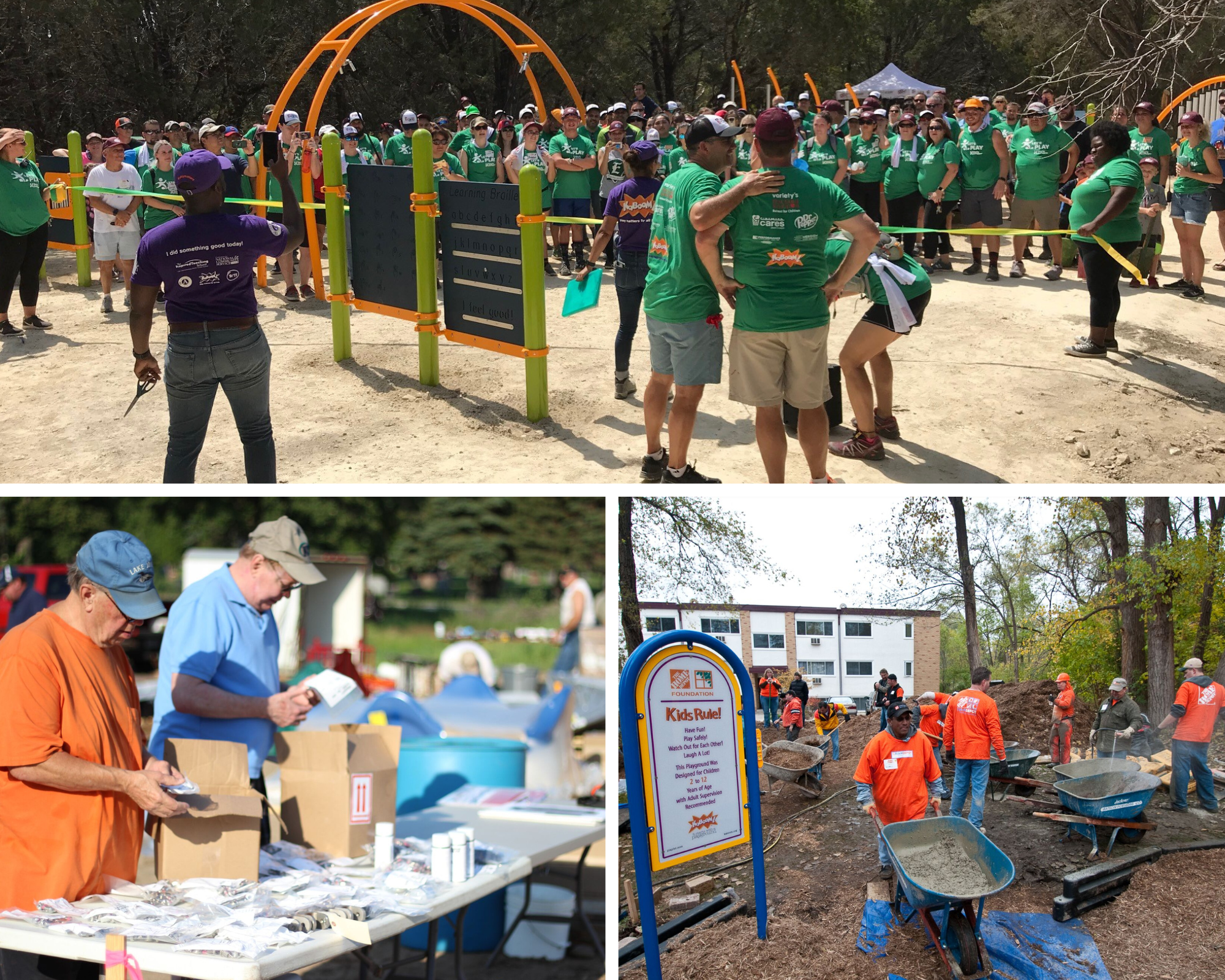A Guide to Securing Inclusive Playground Funding and Resources
Introduction
Inclusive play spaces provide significant benefits to every member of the community. Offering exciting activities and challenges, they entice and welcome everyone to play together. However, inclusive playgrounds can be a substantial investment, and when operating within a constrained budget, securing playground funding may appear as a significant hurdle to overcome. Nevertheless, with persistence, flexibility, creativity, and well-thought-out playscape planning, you will be able to attract diverse financial support and transform your inclusive playground dreams into reality.
Funding Success Story
During a visit with her family in Wisconsin, Rachael Churchill stumbled upon a unique playground that was advertised as the “Possibility Playground.” This all-inclusive and fully accessible space sparked a realization within her—Fort Worth lacked such an offering for its citizens. Upon returning home to Fort Worth, Rachael embarked on a mission to bring the inclusive playground concept back and begin creating a space that all children can enjoy.
Joining forces with her friends, Sandy Mesch of Mesch PLLC and Corrie Watson of Frank Kent Motor Company, they established the 501(c)3 nonprofit organization named Dream Park Fort Worth (DPFW) in 2013. Through dedicated efforts, including donations, sponsorships, and support from over 30 community organizations, they successfully raised the $3.1 million necessary to bring this dream playscape to life. Conceived, developed, funded, and made possible by these three Fort Worth women who recognized a need, the park now stands as a testament to their courage, hard work, and generosity. Due to their vision, the park now belongs to the families of Fort Worth, significantly benefiting the entire community.
Finding Funding for an Inclusive Playscape
Understanding Grant Opportunities
There are numerous organizations that recognize the positive impact playgrounds have on communities, prompting them to allocate playground funding to support construction through grants. Here are some examples:
American ExpressAmerican Express operates three divisions within its grant program, with one specifically dedicated to community service. This division could be a fitting option for funding the playgrounds installation.
Additional Information:
- Grant amounts may vary throughout the year.
- Be considerate of rolling deadlines for applications.
KABOOM! collaborates with corporate sponsors to establish play areas in communities. Their grants can offer flexibility, allowing applications to be submitted at any time of the year.
Additional Information:
- These grant amounts vary.
- Applications can be submitted any time of year, allowing for opportunities when they arise.
- Access more information from the KABOOM! website.
Oliver Foundation
The Oliver Foundation aims to promote healthier eating and physical activity patterns among Pre-School, Elementary, and Middle School children, fostering positive changes within Texas communities.
Additional Information:
- Access more information from the Oliver Foundation website.
Eligible applicants for this grant include political subdivisions of the State of Texas with a legal responsibility to provide public recreation services to their citizens.
Additional Information:
- Access more grant information from the Texas Parks and Wildlife Department website.
As a private philanthropic organization, The Scoular Foundation is dedicated to enhancing the quality of human life in the communities where Scoular employees live and work.
Additional Information:
- Access more community involvement information from The Scoular Foundation website.
When exploring grant opportunities, consider local organizations that share values similar to your playground’s goals. This approach increases the likelihood of finding grants that align perfectly with your playground project. While Landscape Structures does not directly provide grants, completing their grant request form can lead you to comprehensive grant resources. This includes federal and state programs, along with grants offered by corporations, potentially fitting your playground funding needs.
By strategically applying for grants from organizations like these and aligning with local entities, you can enhance your prospects of securing the necessary playground funding for your community projects.
Crowdfunding and Community Fundraising
Playground fundraising events and activities stand out as some of the most effective sources for securing playground funding. Not only do they provide significant financial backing for the new space, but they also foster a sense of unity within the community, working towards a common goal. Fundraising activities encompass a range of options, including bake sales, bingo nights, car washes, silent live auctions, and more. Leverage the resources within your community by seeking assistance from individuals experienced with fundraising events. Their familiarity with successful strategies tailored to your community can be invaluable, guiding you toward the most effective approaches to attain your playground funding goals.
It’s essential to recognize that individuals often seek a tangible reward or recognition for their financial contributions. To address this, consider providing rewards for specific donation amounts. For example, a donation of more than $200 towards your playground fund could result in the individual's name being placed on a brick in the new park. Alternatively, you can provide recognition through plaques or signs. Another engaging option is to invite individuals to sponsor specific playground equipment items such as swings, benches, or activity panels. This personalized approach fosters a sense of “ownership” for contributors, making them more supportive of your cause and creating a stronger connection with your playscape.
Leveraging Resources for an Inclusive Playscape
Collaborating with Local Organizations
Numerous organizations commit both time and resources to support the establishment of inclusive play spaces, fostering environments where children of all abilities and backgrounds can come together. In addition, these groups are not only great for developing playground funding but also for finding community supporters and volunteers.
Kiwanis International, founded in 1915, is a global organization of volunteers that is dedicated to changing the world, one child and one community at a time. They have nearly 600,000 members in 80 countries and geographic areas. They host nearly 150,000 service projects each year having a positive impact on millions of lives. In 2013, Landscape Structures aligned with Kiwanis as a Vision Partner, sharing the goal of bringing play and playgrounds to communities worldwide.
KABOOM! serves as a national nonprofit organization, mobilizing communities to finance, plan, and construct playgrounds throughout the nation. Their dedication lies in ensuring that every child in America experiences a childhood rich in balanced and active play essential for thriving. Over its 25-year history, KABOOM! has built or improved over 17,000 play spaces, while engaging with more than 1.5 million community members and reaching over 11.5 million children.
In the state of Texas, a notable local organization is Be An Angel. Their mission revolves around enhancing the quality of life for children with special needs by providing adaptive equipment, hearing devices, select services, and support programs. Over 36 years of operation, Be An Angel has constructed over 38 inclusive playgrounds throughout the state of Texas.
When seeking collaborations and support for playground funding, explore local organizations within your community whose values align with the inclusive playground you aim to establish. Such partnerships can significantly contribute to the success of your inclusive playground initiative while fostering a sense of community engagement and shared values.
Seeking Local Business Support and Volunteers
Numerous local businesses are eager to contribute to initiatives that enhance the well-being of their communities. This support may manifest in various forms, such as a restaurant or shop donating a portion of their profits for a designated night, providing a substantial monetary gift, or offering smaller donations suitable for an auction or raffle.
Certain businesses might also extend support in the form of materials, labor, or equipment and supplies, thereby alleviating the reliance on financial donations. For example, a local landscaping company may be able to contribute trees, shrubs, and labor, while a printing company could provide support by printing your fundraising flyers. To enhance the success of your outreach, consider offering recognition or publicity with a business’s support. Playground projects present excellent advertising opportunities for companies, and it’s crucial to position them as such. Highlighting the potential benefits for businesses can foster increased engagement and support for your playground funding initiatives.
Education
If you encounter challenges in securing playground funding for your inclusive space, it might be due to a lack of comprehensive understanding within your community regarding the importance and benefits of inclusive playgrounds. Educating the community and articulating the “why” behind the initiative sparks the passion necessary to drive these projects and garner the proper support. Once people genuinely understand the significance, you can potentially engage more people and attract additional volunteers for playground funding, outreach efforts, or other various project needs.
Local Media
Effectively leveraging local media constitutes a powerful strategy for sharing the narrative behind your inclusive playground with the public and your community. When potential donors are familiar with the backstory or the compelling “why” behind your inclusive playground plans, there exists a likelihood that they will be more inclined to contribute financially. Raising funds to construct an inclusive playground, where every child has the opportunity to simply be a kid, represents a heartwarming narrative that newspapers and media outlets might actively promote, injecting positive news into the community. Providing your local media outlets with a concise yet comprehensive summary of your story, elaborating on the reasons behind your inclusive playground initiative, highlighting its significance, and defines the avenues through which people can contribute or participate. This exposure will very likely contribute to more playground funding donations but also potential volunteers willing to contribute their labor—equally as important to the project’s success.
Apply for 501(c)3 status
You may want to consider setting up a nonprofit organization prior to fundraising for your playground. Setting up a nonprofit (often specifically as a 501(c)(3) organization in the United States) offers several advantages, which contribute to your ability to fulfill its your mission and receive support from donors, the community, and various funding sources. Here are some pros & cons for reasons to setup as a nonprofit:
Advantages:
Tax Exemption: Nonprofit organizations, particularly those with 501(c)(3) status in the U.S., are typically exempt from federal and state income taxes. This allows the organization to allocate more resources directly toward its charitable activities.
Tax Deductible Contributions: Donors to nonprofit organizations can usually deduct their contributions from their taxable income. This provides an incentive for individuals and businesses to donate to the organization, increasing the potential for fundraising success.
Access to Grants: Nonprofits often have access to a broader range of grants from foundations, government agencies, and other charitable entities. Many grantors specifically limit their funding to tax-exempt organizations, making nonprofit status essential for accessing these resources.
Credibility and Trust: Nonprofit status can enhance an organization's credibility and trustworthiness. Potential donors, supporters, and partners may be more willing to engage with and support an organization that is officially recognized as a nonprofit, as it signals a commitment to a mission rather than profit.
Community Support: Establishing a nonprofit organization often involves community engagement and participation. The nonprofit structure can facilitate collaboration with local communities, fostering a sense of ownership and support for the organization's initiatives.
Limited Liability Protection: Like for-profit entities, nonprofits provide a level of limited liability protection for individuals involved in the organization. This means that the personal assets of board members and employees are generally protected from legal claims against the organization.
Access to Volunteers: Many people are motivated to volunteer for organizations that are dedicated to a social or community cause. Nonprofits can benefit from the goodwill of volunteers who contribute their time and skills to advance the organization's mission.
Networking Opportunities: Nonprofits often have the opportunity to network with other organizations, government agencies, and stakeholders within their sector. This can lead to collaborative efforts, shared resources, and increased visibility for the organization.
Disadvantages:
Cost: Creating a nonprofit organization takes time, effort, and money. Fees are required to apply for incorporation and tax exemption. The use of an attorney, accountant, or other consultant may also be necessary.
Paperwork: As an exempt corporation, a nonprofit must keep detailed records and submit annual filings to the state and IRS by stated deadlines in order to keep its active and exempt status.
Shared control: Although the people who create nonprofits like to shape and control their creations, personal control is limited. A nonprofit organization is subject to laws and regulations, including its own articles of incorporation and bylaws. In some states, a nonprofit is required to have several directors, who in turn are the only people allowed to elect or appoint the officers who determine policy.
Scrutiny by the public: A nonprofit is dedicated to the public interest; therefore, its finances are open to public inspection. The public may obtain copies of a nonprofit organization's state and Federal filings to learn about salaries and other expenditures.
It's important to note that setting up and maintaining a nonprofit organization requires adherence to certain legal and regulatory requirements, and there are costs associated with the process. It's advisable to consult with legal and financial professionals to ensure compliance with relevant laws and to develop a sustainable funding strategy for your playground project.
Conclusion
Raising the funds for an inclusive playground can be undoubtedly a challenge, but the end product is profoundly rewarding. The story of Dream Park Fort Worth serves as a testament to the transformative power of dedication, collaboration, and creative fundraising efforts. Rachael Churchill and her team's success in raising $3.1 million exemplifies how a community's vision can become a reality with persistent and strategic efforts.
Engaging the community through fundraisers, sponsorships, and collaborations with local entities is key. Researching grants, leveraging local media, and considering nonprofit status are valuable components of a robust strategy for successful playground funding. By aligning with local entities and strategically applying for grants, communities can enhance their chances of securing the necessary funding to bring inclusive playground projects to fruition.
Community fundraising emerges as a powerful tool not only for financial backing but also for building a sense of unity and ownership within the community. Tailoring fundraising strategies to offer tangible rewards and recognition for contributors fosters a deeper connection and commitment to the cause, making individuals feel personally invested in the success of the inclusive playscape.
In essence, creating inclusive play spaces requires a multi-faceted and strategic approach. The combination of strategic approaches can pave the way for the successful realization of inclusive playgrounds that benefit and unite communities, fostering a sense of belonging for children of all abilities and backgrounds. Through perseverance, creativity, and community engagement, the dream of an inclusive playspace can become a shared reality for your community.
If you need additional guidance or tips for optimizing your playground funding, don’t hesitate to reach out to a Whirlix representative. Good luck with preparing for your inclusive playground project and we hope this was an excellent resource to get you started!

-1.png)


